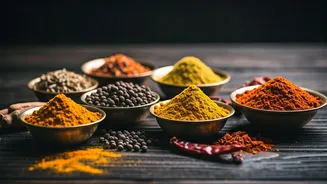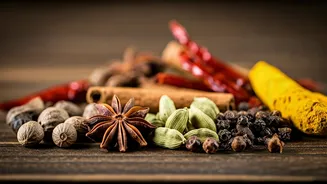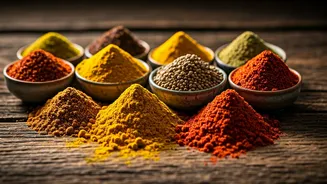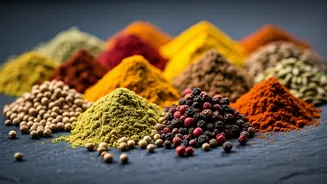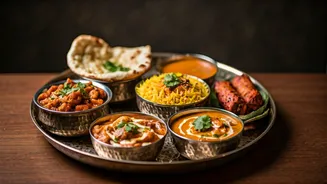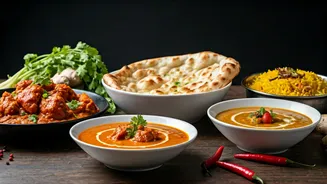A Land of Flavors
India's culinary landscape is as vast and varied as its geography. Each region boasts unique flavors, cooking styles, and staple ingredients, shaped by
local traditions and available resources. The cuisine of the North, influenced by Mughal rule, is characterized by rich, creamy curries, the use of dairy products, and the prevalence of tandoor cooking. Think of the iconic butter chicken, creamy palak paneer, and aromatic biryanis. In contrast, South Indian cuisine is known for its lighter, spicier dishes, using coconut milk, tamarind, and a variety of lentils and rice. Popular dishes include dosas, idlis, and a range of flavorful curries like sambar and rasam. The West showcases a blend of influences, with Gujarati cuisine known for its vegetarian dishes and subtle sweetness, while Maharashtrian cuisine offers a fiery kick. The East offers dishes that combine spices with seafood and desserts. This diversity makes Indian food a global sensation.
Essential Indian Spices
The secret to authentic Indian flavors lies in the expert use of spices. These aren't just for adding heat; they contribute complex aromas, colors, and textures. Turmeric, known for its vibrant yellow color and anti-inflammatory properties, is a staple in most Indian dishes. Coriander seeds provide a citrusy and slightly floral note, while cumin adds a warm, earthy flavor. Chili peppers, ranging from mild to intensely hot, are used to add heat, and the type used varies according to the region and dish. Cardamom, with its aromatic and sweet flavor, is often found in both savory and sweet dishes. Garam masala, a blend of several spices, is frequently added towards the end of cooking to infuse dishes with a complex aroma. Mastering these spices is the first step towards recreating the magic of Indian cuisine. Experimenting with spice combinations unlocks a world of flavor.
Cooking Methods Unveiled
Indian cooking utilizes a variety of methods that contribute to its unique flavors. Frying is a common technique used for creating crispy snacks and flavorful starters. Tandoor cooking, originating from the North, involves cooking food in a cylindrical clay oven, imparting a smoky flavor. Grilling and roasting are also employed to enhance flavors. Sautéing spices and vegetables in hot oil or ghee, often the first step in preparing a dish, releases their essential oils and flavors, forming the base of many curries and stews. Steaming is a traditional way to cook certain types of rice, vegetables, and dumplings. The choice of cooking method depends on the dish, regional traditions, and desired flavor profile. Each method contributes a distinctive element to the final outcome of the food, thus creating a varied and interesting flavor profile.
Must-Try Indian Dishes
Embark on your culinary adventure and start with some must-try Indian dishes. Butter chicken, a creamy tomato-based curry with tender chicken, is a beloved dish across the globe. Palak paneer, a spinach and cheese curry, offers a vegetarian delight. Biryani, a fragrant rice dish often cooked with meat, vegetables, and aromatic spices, is a celebration of flavors and textures. Dosas, crispy fermented lentil pancakes served with various fillings, are a South Indian staple. Samosas, deep-fried pastry filled with spiced potatoes, offer a popular street food. Thalis, platters with a selection of different dishes, are a great way to sample a variety of flavors and regional specialities. Each dish has its own story, ingredients, and significance, reflecting India's incredible culinary tapestry.
Regional Cuisine Spotlight
Delve into the regional specialities to gain a better appreciation of the Indian culinary landscape. In North India, look for dishes like chole bhature, a chickpea curry served with fried bread, and malai kofta, vegetable balls in a creamy sauce. South India offers idli-sambhar, a popular breakfast dish, and the flavorful Chettinad curries. Gujarati cuisine offers a vegetarian experience. Coastal regions present a variety of seafood dishes. Every region adds its distinct touch, creating a symphony of flavors that reflects the diverse traditions and ingredients of the Indian subcontinent. Exploring these specialities allows you to understand the evolution of each dish and the cultural elements that make them unique.



